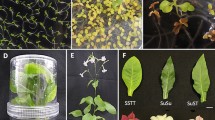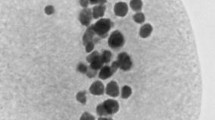VIII. Summary
An interspecific hybrid betweenOryza sativa ×O. officinalis was obtained for the first time. The plant was intermediate in character between the two parents and was highly sterile.
The meiosis in the hybrid is described. The parental chromosomes failed to pair in meiosis. Irregular division and distribution of univalents at both divisions generally resulted in abnormal pollen. In certain cells, however, the univalents appeared to divide regularly at both the divisions, presumably giving rise to diploid gametes.
Six plants resulting from back-crosses of theF 1 with one of the parents,O. sativa, all proved to be triploids, thereby showing that diploid gametes are occasionally formed by double division of all the univalent chromosomes.
The meiosis in these plants was extremely abnormal. Coalescence and degeneration of P.M.C. was frequent. Formation of restitution nuclei, failure of septa formation in the P.M.C., suppression of the first division and other abnormalities were also frequently met with.
The formation of diploid gametes and the origin of polyploidy is discussed with special reference to their occurrence in rice.
Similar content being viewed by others
References
Aase, H. C. (1930). “The cytology ofTriticum, Secale andAegilops hybrids with reference to phylogeny.”Res. Stud. St. Coll. Wash.2, 3–60.
—— (1935). “Cytology of cereals.”Bot. Rev. 1, 467–96.
Arnason, T. J. (1936). “Cytogenetics of hybrids betweenZea mays andEuchlaena mexicana.”Genetics,21, 40–60.
Arutjunova (1936). “An investigation of chromosome morphology in the genusGossypium.”C. R. Acad. Sci. U.R.S.S.3, 37–40.
Babcock, E. B. &Emsweller, S.L. (1936). “Meiosis in certain interspecific hybrids inCrepis and its bearing on taxonomical relationship.”Univ. Calif. Publ. agric. Sci.6, 325–68.
Beadle, G. W. (1931). “A gene in maize for supernumerary cell divisions following meiosis.”Mem. Cornell agric. Exp. Sta. No. 135.
Breslavetz (1929). “Zytologische Studien überMelandrium album L.”Planta,7, 444–60.
Buxton, B. H. &Newton, W. C. F. (1928). “Hybrids ofDigitalis ambigua andDigitalis purpurea, their fertility and cytology.”J. Genet.19, 269–79.
Clausen, J. (1926). “Genetical and cytological investigations onViola tricolor L. andViola arvensis Murr.”Hereditas, Lund,8, 1–157.
—— (1931a). “Genetic studies inPolemonium. III. Preliminary account of the cytology of species and specific hybrids.”Hereditas, Lund,15, 62–6.
—— (1931b). “Cytogenetic and taxonomic investigations inMelanium violets.”Hereditas, Lund,15, 219–308.
Clausen, R. E. &Goodspeed, T. H. (1925). “Interspecific hybridization inNicotiana. II. A tetraploidglutinosa-Tabacum hybrid, an experimental verification of Winge’s hypothesis.”Genetics,10, 279–84.
Cleland, R. E. (1929). “Chromosome behaviour in the pollen mother cells of several strains ofOenothera Lamarckiana.”Z. indukt. Abstamm.- u. VererbLehre,51, 126–45.
Collins, J. L., Hollingshead, L. &Avery, P. (1929). “Interspecific hybrids inCrepis. III. Constant fertile forms containing chromosomes derived from two species.”Genetics,14, 305–20.
Collins, J. L. &Mann, M. (1923). “Interspecific hybrids inCrepis. II.”Genetics,8, 212–32.
Crew, F. A. E. &Koller, P. C. (1935–6). “Genetical and cytological studies of the intergeneric hybrid ofCairina moschata andAnas platyrhyncha.”Proc. Roy. Soc. Edinb.54, 210–41.
Darlington, C. D. (1929). “Chromosome behaviour and structural hybridity in the Tradescantiae.”J. Genet.21, 207–86.
—— (1930). “Studies inPrunus. III.”J. Genet. 22, 65–93.
-- (1937).Recent Advances in Cytology, 2nd ed. London.
Dermen, H. (1931). “A study of chromosome number in two genera of Berberidaceae.”J. Arnold Arb.12, 281–7.
—— (1936). “Cytological study and hybridization in two sections ofVerbena.”Cytologia, Tokyo,7, 160–75.
Erlanson, E. W. (1929). “Cytological conditions and evidences for hybridity in North American wild roses.”Bot. Gaz.87, 443–506.
Federley, H. (1928). “Chromosomenverhältnisse bei Mischlingen.”Verh. int. Kongr. Vererbungswissens, Berlin, 1927, Suppl. pp. 194–222.
—— (1932). “The conjugation of the chromosomes.”Proc. 6th Int. Congr. Genet. 1, 153–64.
Fukushima, E. (1931). “Formation of diploid and tetraploid gametes inBrassica.”Jap. J. Bot.5, 273–83.
Gaines, E. F. &Aase, H. C. (1926). “A haploid wheat plant.”Amer. J. Bot.13, 373–85.
Gates, R. R. &Nandi, H. K. (1935). “The cytology of trisomic mutations in a wild species ofOenothera.”Philos. Trans. B,225, 227–54.
Gates, R. R. &Rees, E. M. (1921). “A cytological study of pollen development inLactuca.”Ann. Bot., Lond.,35, 365–98.
Goodspeed, T. H. (1923). “A preliminary note on the cytology ofNicotiana species and hybrids.”Svensk. bot. Tidskr.17.
—— (1934). “Nicotiana phylesis in the light of chromosome number, morphology and behaviour.”Univ. Calif. Publ. Bot. 17, 369–98.
Goodspeed, T. H. &Clausen, R. E. (1927). “Interspecific hybridization inNicotiana. VI. Cytological features ofsylvestris-Tabacum hybrids.”Univ. Calif. Publ. Bot.11, 127–40.
Gustaffson, A. (1935). “Studies on the mechanism of parthenogenesis.”Hereditas, Lund,21, 1–112.
Haase-Bessell, G. (1916). “Digitalisstudien. I.”Z. indukt. Abstamm.- u. VererbLehre,16, 293–314.
Hollingshead, L. (1930a). “A lethal factor inCrepis effective only in an interspecific hybrid.”Genetics,15, 114–40.
—— (1930b). “A cytological study of haploidCrepis capillaris plants.”Univ. Calif. Publ. agric. Sci. 6, 107–34.
—— (1932). “The occurrence of unpaired chromosomes in hybrids between varieties ofTriticum vulgare.”Cytologia, Tokyo,3, 119–41.
Huskins, C. L. (1931). “The origin ofSpartina Townsendii.”Genetica,12, 531–38.
Jorgensen, C. A. (1928). “The experimental formation of heteroploid plants in the genusSolanum.”J. Genet.19, 133–211.
Karpechenko, G. D. (1927). “The production of polyploid gametes in hybrids.”Hereditas, Lund,9, 349–68.
—— (1928). “Polyploid hybrids ofRaphanus sativus L. ×Brassica oleracea L.”Z. indukt. Abstamm.- u. VererbLehre,48, 1–85.
—— (1929). “A contribution to the synthesis of a constant hybrid of three species.”Proc. U.S.S.R. Congr. Genetics, Leningrad,2, 277–94.
Kihara, H. (1931). “Genomanalyse beiTriticum undAegilops. II.Aegilotricum undAegilops cylindrica.”Cytologia, Tokyo,2, 106–55.
Kostoff, D. (1936). “The origin of cultivated tobacco.”Bull. Biol. Med. Exp.1, 395.
La Court, L. (1931). “Improvements in everyday technique in plant cytology.”J. R. micr. Soc.51, 119–26.
Lammerts, W. E. (1929). “Interspecific hybridization inNicotiana. IX. Further studies of the cytology of the back-cross progenies of thePaniculata-Rustica hybrid.”Genetics,14, 286–304.
—— (1932). “An experimentally produced secondary polyploid in the genusNicotiana.”Cytologia, Tokyo,4, 38–45.
Lesley, M. M. (1926). “Maturation in diploid and triploid tomatoes.”Genetics,11, 267–79.
Lesley, M. M. &Frost, H. B. (1927). “Mendelian inheritance of chromosome shape inMatthiola.”Genetics,12, 449–60.
—— —— (1928). “Two extreme ‘small’Matthiola plants; a haploid with one and a diploid with two additional fragments.”Amer. Nat. 62, 22–33.
Levitsky, G. A. &Benetzkaia, G. K. (1929). “Cytological investigation of constant intermediate rye-wheat hybrids.”Bull. Appl. Bot. Genet. Pl. Breed. pp. 345–52.
—— —— (1929). “Cytology of wheat-rye amphidiploids.”Bull. Appl. Bot. Genet. Pl. Breed. 27, 241–64.
Longley, A. E. &Sando, W. H. (1930). “Nuclear divisions in the pollen mother cells ofTriticum, Aegilops andSecale and their hybrids.”J. agric. Res.40, 683–719.
Mather, K. (1935). “Chromosome behaviour in a triploid wheat hybrid.”Z. Zellforsch.23, 117–38.
—— (1937). “Notes on the cytology of somePrunus species.”Genetica,19, 143–52.
McClintock, B. (1929). “A cytological and genetical study of triploid maize.”Genetics,14, 180–222.
—— (1933). “The association of non-homologous parts of chromosomes in the midprophase of meiosis inZea mays.”Z. Zellforsch. 19, 191–237.
Meurman, O. (1928). “Cytological studies in the genusRibes L.”Hereditas, Lund,11, 289–356.
Morinaga, T. (1929a). “Interspecific hybridization inBrassica. I. The cytology ofF1 hybrids ofB. napella and various other species with 10 chromosomes.”Cytologia, Tokyo,1, 16–27.
—— (1929b). “Interspecific hybridization inBrassica. II. The cytology ofF 1 hybrids ofB. cernua and various other species with 10 chromosomes.”Jap. J. Genet. 4, 277–89.
—— (1931). “Interspecific hybridization inBrassica. IV. The cytology of hybrids ofB. carinata and some other species with 10 chromosomes.”Cytologia, Tokyo,3, 77–83.
Morinaga, T. &Fukushima, E. (1935). “Cytogenetical studies inOryza sativa L. II. Spontaneous autotriploid mutants inOryza sativa L.”Jap. J. Bot.7, 207–25.
Muntzing, A. (1930). “Outlines to a genetic monograph on the genusGaleopsis.”Hereditas, Lund,13, 185–341.
—— (1934). “Chromosome fragmentation in aCrepis hybrid.”Hereditas, Lund,19, 284–302.
—— (1935). “Chromosome behaviour in someNicotiana hybrids.”Hereditas, Lund,20, 251–71.
—— (1929). “Karyological studies of the Narcissus plant. I.”Mem. Coll. Sci. Kyoto, B.4, 175–98.
—— (1933). “Number and behaviour of chromosomes in the genusNarcissus.”Mem. Coll. Sci. Kyoto, B,8, 81–200.
Naithani, S. P. (1936). “Chromosome studies inHyacinthus orientalis.” (Unpublished).
Navashin, M. (1927). “Über die Veränderung von Zahl und Form der Chromosomen infolge der Hybridisation.”Z. Zellforsch.6, 195–233.
—— (1933). “The dislocation hypothesis of evolution of chromosome numbers.”Z. indukt. Abstamm.- u. VererbLehre,63, 224–31.
—— (1934). “Chromosome alterations caused by hybridization and their bearing upon certain general genetic problems.”Cytologia, Tokyo,5, 169–203.
Newton, C. W. F. &Pellew, C. (1929). “Primula Kewensis and its derivatives.”J. Genet.20, 405–67.
Nishiyama, I. (1929). “The genetics and cytology of certain cereals. I. Morphological and cytological studies on triploid, pentaploid and hexaploidAvena hybrids.”Jap. J. Genet.5, 1–48.
Percival, J. (1930). “Cytological studies of some hybrids ofAegilops sp. × wheats, and of some hybrids between different species ofAegilops.”J. Genet.22, 201–78.
Ramanujam, S. (1937a). “Cytogenetical studies in the Oryzeae. I.” (Unpublished.)
—— (1937b). “Cytogenetical studies in the Oryzeae. II.”J. Genet. 35, 183–222.
Ramiah, K., Parthasarathy, N. &Ramanujam, S. (1933). “A triploid plant in rice.”Current Sci.2, 170–1.
—— —— (1934). “A haploid plant in rice.”J. Ind. Bot. Soc. 13, 153–64.
Randolph, L. F. (1932). “Some effects of high temperature on polyploidy and other variations in maize.”Proc. nat. Acad. Sci., Wash.,18, 222–9.
Rohweder, H. (1934). “Beiträge zur Systematik und Phylogenie der GenusDianthus.”Bot. Jrb.66, 249–368.
Roschevicz (1931). “A contribution to the knowledge of rice.”Bull. Appl. Bot. Genet. Pl. Breed.27, No. 4.
Rosenberg, O. (1927). “Die Semiheterotypische Teilung und ihre Bedeutung für die Entstehung verdoppelter chromosomenzahlen.”Hereditas, Lund,8, 305–38.
Sakamura, T. (1920). “Experimentelle Studien über die Zell-und Kernteilung, etc.”J. Coll. Sci. Tokyo,39 (ii), 1–221.
Sapěhin, L. A. (1933). “The genes of the reduction division.”Bull. Appl. Bot. Genet. Pl. Breed. Ser. IId, No. 5, pp. 43–75.
Sax, K. (1928). “Chromosome behaviour inTriticum hybrids.”Z. indukt. Abstamm.-u. VererbLehre, Suppl. 2.
—— (1931). “Chromosome numbers in the ligneous Saxifragaceae.”J. Arnold Arb. 12, 198–206.
—— (1935). “The cytological analysis of species hybrids.”Bot. Rev. 1, 100–17.
Skovsted, A. (1929). “Cytological investigations of the genusAesculus L.”Hereditas, Lund,12, 64–70.
Author information
Authors and Affiliations
Additional information
Part III of thesis approved for the degree of Doctor of Philosophy in the University of London.
Rights and permissions
About this article
Cite this article
Ramanujam, S. Cytogenetical studies in the oryzeae. Journ. of Genetics 35, 223–258 (1937). https://doi.org/10.1007/BF02982352
Issue Date:
DOI: https://doi.org/10.1007/BF02982352




